Motion pictures and TV displays like to depict robots who can perceive and communicate again to people. Presentations like Westworld, motion pictures like Megastar Wars and I, Robotic are stuffed with such marvels. However what if all of this exists at the moment? Which it without a doubt does. You’ll write a program that understands what you are saying and reply to it.
All of that is conceivable with the assistance of speech reputation. The use of speech reputation in Python, you’ll create systems that select up audio and perceive what’s being mentioned. On this instructional titled ‘The whole lot You Wish to Know About Speech Reputation in Python’, you’re going to be told the fundamentals of speech reputation.
What’s Speech Reputation?
Speech Reputation comprises laptop science and linguistics to spot spoken phrases and converts them into textual content. It lets in computer systems to grasp human language.

Determine 1: Speech Reputation
Speech reputation is a device’s skill to hear spoken phrases and establish them. You’ll then use speech reputation in Python to transform the spoken phrases into textual content, make a question or give a answer. You’ll even program some units to answer those spoken phrases. You’ll do speech reputation in python with the assistance of laptop systems that soak up enter from the microphone, procedure it, and convert it into an acceptable shape.
Speech reputation turns out extremely futuristic, however it’s provide throughout you. Automatic telephone calls let you discuss out your question or the question you want to be assisted on; your digital assistants like Siri or Alexa additionally use speech reputation to speak to you seamlessly.
How Does Speech Reputation paintings?
Speech reputation in Python works with algorithms that carry out linguistic and acoustic modeling. Acoustic modeling is used to acknowledge phenones/phonetics in our speech to get the extra vital a part of speech, as phrases and sentences.

Determine 2: Operating of Speech Reputation
Speech reputation begins by means of taking the sound power produced by means of the individual talking and changing it into electric power with the assistance of a microphone. It then converts this electric power from analog to virtual, and in any case to textual content.
It breaks the audio knowledge down into sounds, and it analyzes the sounds the use of algorithms to search out essentially the most possible note that matches that audio. All of that is completed the use of Herbal Language Processing and Neural Networks. Hidden Markov fashions can be utilized to search out temporal patterns in speech and enhance accuracy.
Choosing and Putting in a Speech Reputation Package deal
To accomplish speech reputation in Python, you wish to have to put in a speech reputation package deal to make use of with Python. There are more than one applications to be had on-line. The desk under outlines a few of these applications and highlights their strong point.
Package deal |
Capability |
Set up |
|
Apiai |
Contains herbal language processing for figuring out a speaker’s intent |
$ pip set up apiai |
|
Google-cloud-speech |
Gives fundamental speech to textual content conversion |
$pip set up virtualenv virtualenv <your-env> <your-env>Scriptsactivate <your-env>Scriptspip.exe set up google-cloud-speech |
|
Speech Reputation |
Gives clean audio processing and microphone accessibility |
pip set up SpeechRecognition |
|
Watson-developer-cloud |
Watson developer cloud is an Synthetic Intelligence API that makes growing, debugging, operating, and deploying APIs clean. It may be used to accomplish fundamental speech reputation duties. |
pip install-upgrade watson-developer-cloud |
Desk 1: Choosing and putting in a speech reputation package deal
For this implementation, you’re going to use the Speech Reputation package deal. It lets in:
- Simple speech reputation from the microphone.
- Makes it clean to transcribe an audio document.
- It additionally we could us save audio knowledge into an audio document.
- It additionally displays us reputation leads to an easy-to-understand layout.
Putting in Speech Reputation
Putting in speech reputation in Python is a an important step against incorporating tough voice reputation functions into your tasks. Speech reputation, a Python library, facilitates clean get entry to to more than a few speech reputation engines and APIs, making it an indispensable device for a various array of packages. Let’s embark on a adventure to discover the method of putting in Speech Reputation and free up its possible to your tasks.
Set up Steps
1. Python Surroundings Setup
Be sure you have Python put in in your machine. Speech Reputation is suitable with each Python 2 and Python 3 variations. Then again, it is really helpful to make use of Python 3 for compatibility and fortify with the newest options.
2. Set up by the use of Pip
The simplest way to set up Speech Reputation is by the use of pip, the Python package deal installer. Open your command-line interface and execute the next command:
pip set up SpeechRecognition
This command will obtain and set up the SpeechRecognition library at the side of its dependencies.
3. Further Installations (Not obligatory)
Relying in your necessities and personal tastes, you could want to set up further applications for explicit functionalities. For example:
- PyAudio: In the event you intend to seize audio enter from a microphone, you’ll be able to want to set up the PyAudio library. Execute the next command:
pip set up pyaudio
- Notice: PyAudio has dependencies that want to be fulfilled, particularly on sure working techniques like Home windows. Check with the PyAudio documentation for detailed directions.
4. Verification
After set up, you’ll check whether or not Speech Reputation is effectively put in by means of uploading it inside a Python setting. Open a Python interpreter or your most popular Python IDE and execute the next instructions:
import speech_recognition as sr
print(sr.__version__)
If the model selection of Speech Reputation is displayed with none mistakes, congratulations! You may have effectively put in Speech Reputation on your Python setting.
Options and Functions
Speech Reputation empowers builders with an in depth vary of options and functions, together with:
- Multi-Engine Toughen: Speech Reputation supplies get entry to to more than one speech reputation engines and APIs, permitting builders to select the best option for his or her necessities.
- Pass-Platform Compatibility: It’s suitable with main working techniques, together with Home windows, macOS, and Linux, making sure versatility throughout other building environments.
- Microphone Enter: With fortify for microphone enter, builders can seize and procedure real-time audio enter, enabling packages similar to voice instructions, voice-controlled assistants, and dictation instrument.
- Audio Record Processing: Speech Reputation can procedure audio recordsdata in more than a few codecs, enabling transcription, voice-activated automation, and audio research packages.
- Language Toughen: It helps reputation in more than one languages and dialects, facilitating international deployment and localization of packages.
Doable Programs
Speech Reputation opens the door to a myriad of packages throughout various domain names, together with:
- Digital Assistants: Broaden voice-controlled digital assistants for acting duties, fetching data, and managing schedules.
- Transcription Products and services: Construct packages for transcribing audio recordings, interviews, conferences, and lectures into textual content layout.
- Voice-Activated Automation: Create techniques for controlling good units, house automation, and business processes the use of voice instructions.
- Accessibility Answers: Broaden gear to help people with disabilities by means of changing spoken language into textual content or acting movements in keeping with voice instructions.
- Language Finding out: Construct interactive language finding out packages with speech reputation functions for pronunciation evaluation and language apply.
The Recognizer Magnificence
The Recognizer magnificence is a basic element of the SpeechRecognition library in Python, enjoying a central function in processing audio enter and acting speech reputation duties. It serves as the main interface for builders to have interaction with more than a few speech reputation engines and APIs, offering a unified and intuitive strategy to transcribe spoken language into textual content. On this elaborate textual content, we will delve into the intricacies of the Recognizer magnificence, exploring its functionalities, strategies, and utilization patterns.
Assessment
The Recognizer magnificence serves because the cornerstone of SpeechRecognition, providing a cohesive framework for incorporating speech reputation functions into Python packages. It encapsulates the capability required to seize audio enter from other assets, similar to microphone enter or audio recordsdata, and interface with various speech reputation engines.
Key Options
1. Audio Enter Dealing with
The Recognizer magnificence facilitates the purchase of audio enter from more than a few assets, together with:
- Microphone Enter: Taking pictures real-time audio enter from the microphone for reside speech reputation.
- Audio Record Enter: Processing pre-recorded audio recordsdata in numerous codecs (e.g., WAV, MP3) for offline speech reputation.
2. Speech Reputation
The use of the Recognizer magnificence, builders can transcribe speech enter into textual content the use of the selected speech reputation engine or API. This procedure comes to sending audio knowledge to the popularity engine and receiving the corresponding textual content output.
3. Multi-Engine Toughen
The Recognizer magnificence helps integration with more than one speech reputation engines and APIs, giving builders the versatility to select the best option for his or her packages. Usually supported engines come with Google Speech Reputation, Sphinx, and Wit.ai.
4. Language and Configuration Choices
Builders can customise more than a few parameters and configurations of the Recognizer magnificence to optimize speech reputation efficiency. This contains specifying the language style, adjusting sensitivity thresholds, and configuring reputation timeouts.
Strategies and Utilization
The Recognizer magnificence supplies a collection of strategies for acting speech reputation duties, together with:
- recognize_google(): This system plays speech reputation the use of the Google Internet Speech API. It calls for an web connection to ship audio knowledge to Google’s servers for processing.
- recognize_sphinx(): Makes use of the CMU Sphinx engine for offline speech reputation. This system is acceptable for eventualities the place web connectivity is unavailable or for packages with privateness issues.
- recognize_wit(): Interfaces with the Wit.ai API for speech reputation. Wit.ai provides herbal language processing functions, enabling builders to extract intent and entities from the transcribed textual content.
- pay attention(): Captures audio enter from the required supply, such because the microphone or an audio document, and returns a SpeechRecognition AudioData object containing the uncooked audio knowledge.
- document(): Information audio enter from the microphone for a specified period and returns the recorded audio as a SpeechRecognition AudioData object.
Instance Utilization
import speech_recognition as sr
# Create a Recognizer example
recognizer = sr.Recognizer()
# Seize audio enter from the microphone
with sr.Microphone() as supply:
print("Talk one thing...")
audio_data = recognizer.pay attention(supply)
# Carry out speech reputation the use of Google Internet Speech API
take a look at:
textual content = recognizer.recognize_google(audio_data)
print("You mentioned:", textual content)
apart from sr.UnknownValueError:
print("Sorry, may now not perceive audio.")
apart from sr.RequestError as e:
print("Error: May just now not request effects from Google Speech Reputation provider;"
Operating With Audio Recordsdata
Operating with audio recordsdata is a basic side of many programming duties, starting from audio processing and research to speech reputation and transcription. Python, with its wealthy ecosystem of libraries, supplies tough gear for dealing with audio knowledge successfully. On this elaborate textual content, we will discover more than a few sides of operating with audio recordsdata in Python, together with studying, writing, processing, and examining audio knowledge.
Studying Audio Recordsdata
1. The use of Libraries
Python provides a number of libraries for studying audio recordsdata, together with:
- Librosa: A well-liked library for audio and track research, offering functionalities for studying audio recordsdata in more than a few codecs.
- Pydub: A easy and easy-to-use library for audio manipulation, supporting studying and writing audio recordsdata in numerous codecs.
- SpeechRecognition: Despite the fact that essentially fascinated about speech reputation, SpeechRecognition will also be used to learn audio recordsdata for transcription functions.
2. Record Codecs
Audio recordsdata come in numerous codecs, similar to WAV, MP3, FLAC, and OGG. Python libraries normally fortify more than one codecs, permitting builders to paintings with quite a lot of audio recordsdata.
3. Instance
import librosa#
Learn audio fileaudio_data, sample_rate = librosa.load('audio.wav', sr=None)Writing Audio Recordsdata
1. The use of Libraries
Very similar to studying audio recordsdata, Python libraries be offering functionalities for writing audio knowledge to recordsdata in more than a few codecs. Libraries like Pydub and Librosa supply easy-to-use strategies for saving audio knowledge to recordsdata.
2. Instance
import librosa
# Write audio knowledge to document
librosa.output.write_wav('output.wav', audio_data, sample_rate)Processing and Inspecting Audio Information
1. Audio Processing
Python libraries be offering quite a lot of gear for processing audio knowledge, together with:
- Filtering: Making use of filters for noise aid, equalization, and sign enhancement.
- Function Extraction: Extracting options similar to Mel-Frequency Cepstral Coefficients (MFCCs), Spectrograms, and Chroma options for research and classification.
- Time-Frequency Research: Inspecting audio alerts in each time and frequency domain names the use of tactics like Quick-Time Fourier Change into (STFT) and Wavelet Change into.
2. Instance
import librosa
import numpy as np
# Compute Mel-Frequency Cepstral Coefficients (MFCCs)
mfccs = librosa.characteristic.mfcc(y=audio_data, sr=sample_rate, n_mfcc=13)3. Audio Visualization
Visualization gear like Matplotlib can be utilized to visualise audio knowledge, spectrograms, waveforms, and different audio options for research and interpretation.
Speech Reputation in Python: Changing Speech to Textual content
Now, create a program that takes within the audio as enter and converts it to textual content.

Determine 3: Uploading vital modules
Let’s create a serve as that takes within the audio as enter and converts it to textual content.
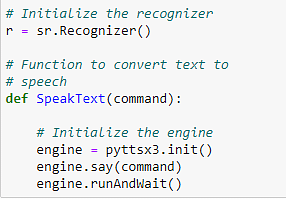
Determine 4: Changing speech to textual content
Now, use the microphone to get audio enter from the person in real-time, acknowledge it, and print it in textual content.
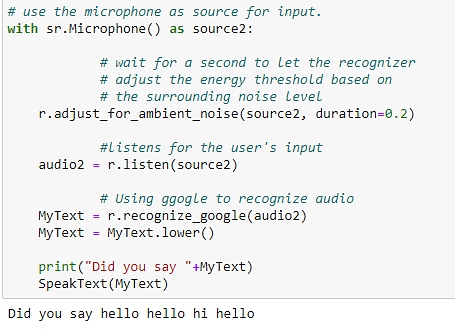
Determine 5: Changing audio enter to textual content
As you’ll see, you’ve carried out speech reputation in Python to get entry to the microphone and used a serve as to transform the audio into textual content shape. Are you able to bet what the person had mentioned?
Opening a URL With Speech
Now that you know the way to transform speech to textual content the use of speech reputation in Python, use it to open a URL within the browser. The person has to mention the identify of the web page out loud. You’ll get started by means of uploading the vital modules.

Determine 6: Uploading modules
Now, use speech to textual content to take enter from the microphone and convert it into textual content. Then you’ll use the microphone serve as to get comments after which convert it into speech the use of google. Then, the use of a get serve as within the internet module, make a browser request for the web page you need to open.
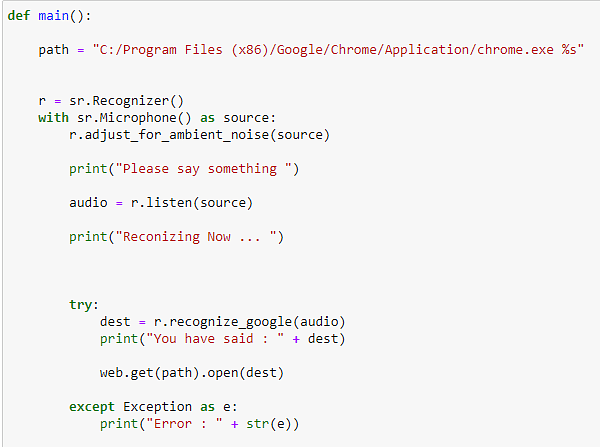
Determine 7: Opening a web site the use of speech reputation
Now, run the serve as and get the output.
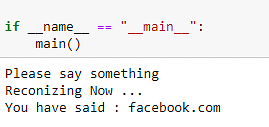
Determine 8: Opening a web site the use of speech reputation
As you’ll see from the above determine, the question has effectively run, another way, an error message would had been thrown. Are you able to bet which web site was once opened?
Speech Reputation in Python Demo: Bet a Phrase Sport
Now, use speech reputation to create a guess-a-word recreation. The pc will select a random note, and you have got to bet what it’s. You get started by means of uploading the vital applications.

Determine 9: Uploading applications
Now, create a serve as to acknowledge what’s being mentioned from the microphone. The serve as is identical, however it’s important to come with exception dealing with in this system.
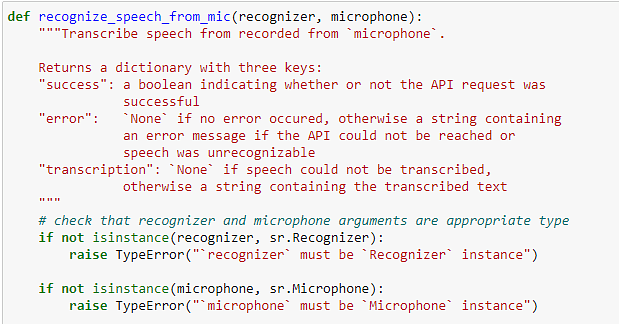
Determine 10: Dealing with microphone exceptions
Now, initialize your recognizer magnificence and take within the microphone enter. You are going to additionally take a look at to peer if the audio was once legible and if the API name malfunctioned.
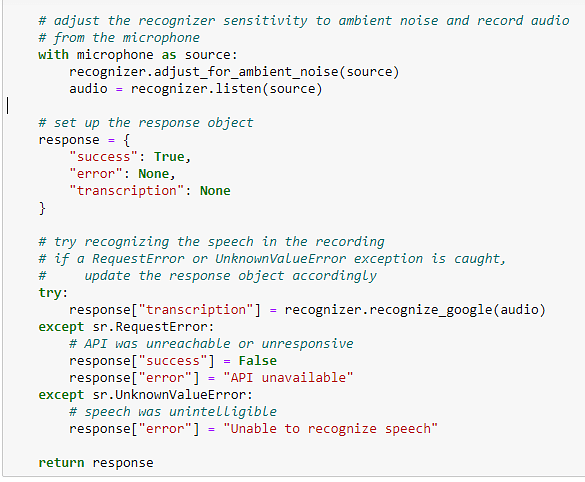
Determine 11: Changing speech to textual content
Now, initialize the microphone. You are going to additionally create an inventory that incorporates the more than a few phrases from which the person should bet. You are going to additionally give the person the directions for this recreation.
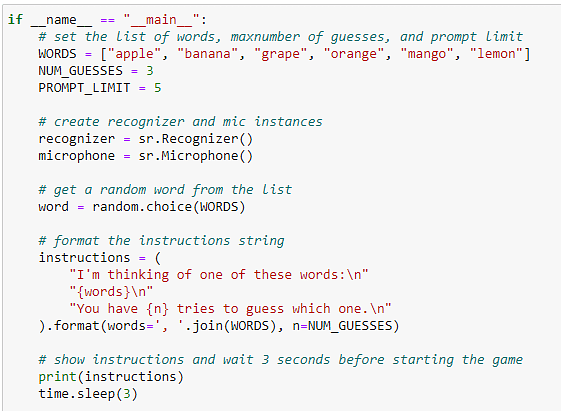
Determine 12: Putting in the microphone
Now, create a serve as that takes in microphone enter three times, tests it with the chosen note, and prints the consequences.
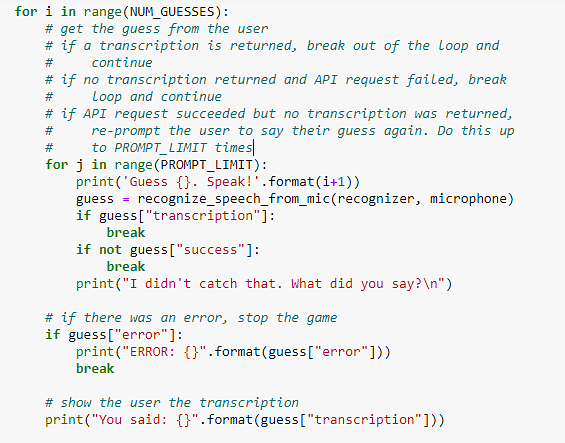
Determine 13: Putting in the sport
The picture under displays the more than a few output messages and the output of this system.
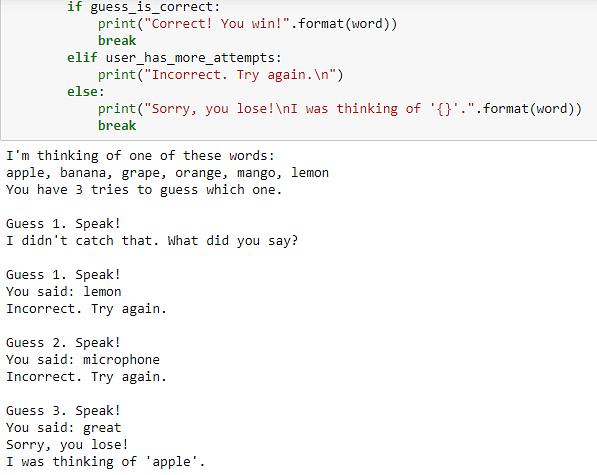
Determine 14: Sport output
From the output, you’ll see that the note selected was once ‘apple’. The person were given 3 guesses and was once fallacious. You’ll additionally see the mistake message which seemed for the reason that person wasn’t audible.
Conclusion
On this Speech Reputation in Python instructional you first understood what speech reputation is and the way it works. Then you definitely checked out more than a few speech reputation applications and their makes use of and set up steps. Then you definitely used Speech Reputation, a python package deal to transform speech to textual content the use of the microphone characteristic, open a URL just by speech, and created a Bet a note recreation. And to realize deeper insights into speech reputation in Python, you’ll go for a complete Java Certification Coaching. This Python Coaching won’t most effective allow you to to have a profound wisdom of more than a few Java subjects however may even make you process in a position very quickly.
FAQs
1. How does speech reputation paintings?
Speech reputation works by means of shooting audio enter, preprocessing the sign to give a boost to its high quality, extracting related options similar to Mel-Frequency Cepstral Coefficients (MFCCs), and the use of a reputation set of rules to compare those options to identified patterns of speech, in the long run changing spoken language into textual content.
2. How one can create a neural community for speech reputation in Python?
To create a neural community for speech reputation in Python, you’ll use deep finding out frameworks like TensorFlow or PyTorch. Outline the structure of the neural community, together with layers similar to convolutional and recurrent layers, and educate the community the use of a big dataset of categorised audio samples.
3. How one can import speech reputation in Python?
Uploading speech reputation in Python is easy the use of the SpeechRecognition library. Merely set up the library the use of pip (pip set up SpeechRecognition) and import it into your Python script the use of import speech_recognition as sr.
4. What’s the easiest speech reputation instrument for Python?
The most productive speech reputation instrument for Python regularly depends upon explicit necessities and personal tastes. In style possible choices come with the SpeechRecognition library for its ease of use and flexibility, in addition to cloud-based APIs like Google Cloud Speech-to-Textual content and IBM Watson Speech to Textual content for his or her complicated options and accuracy.
supply: www.simplilearn.com












